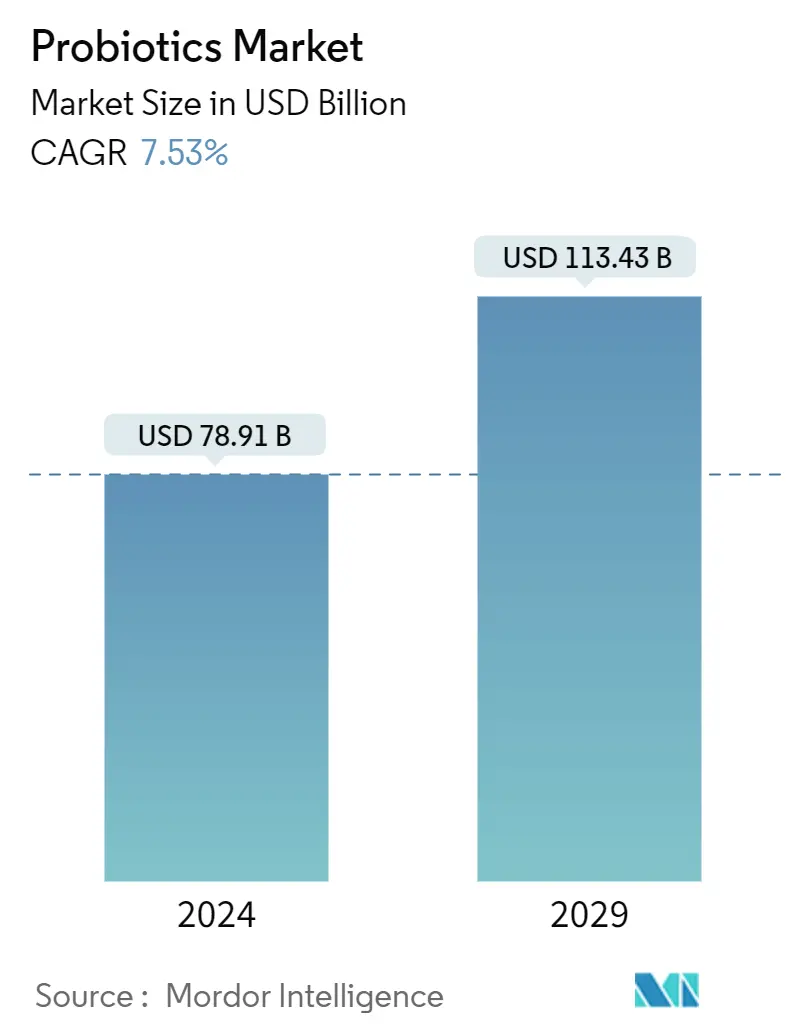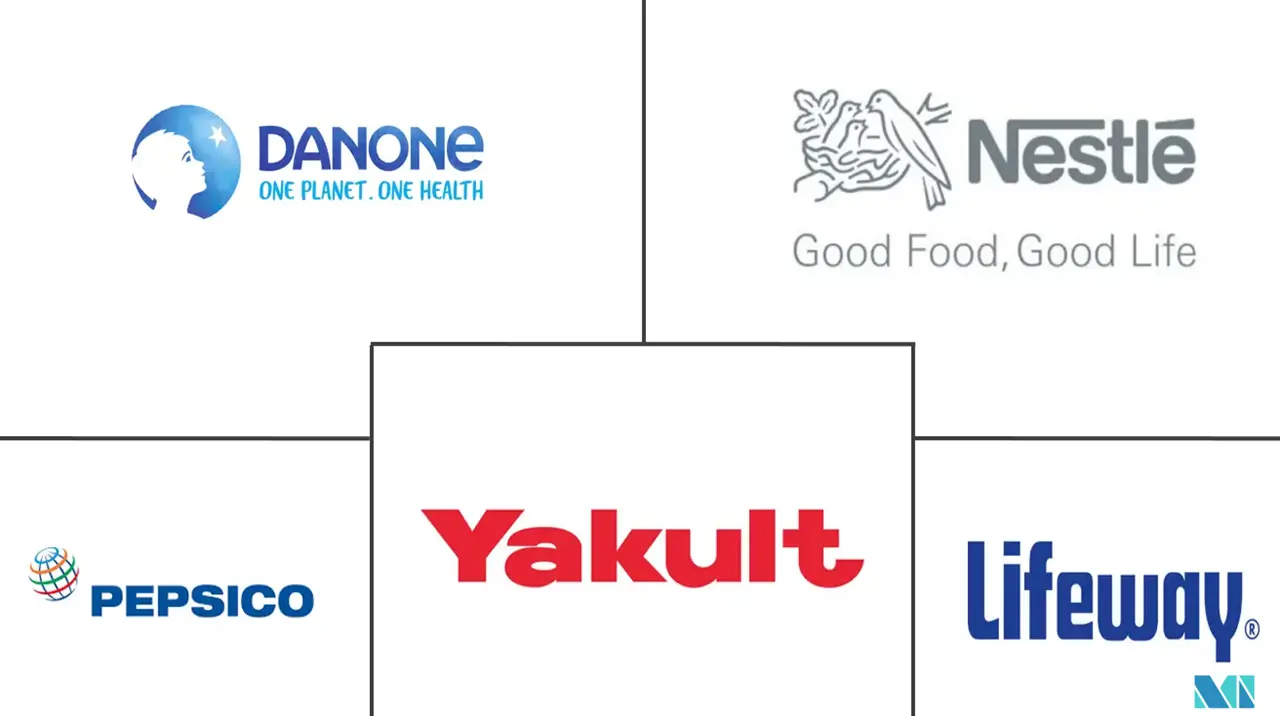Market Size of Probiotics Industry

| Study Period | 2019 - 2029 |
| Market Size (2024) | USD 78.91 Billion |
| Market Size (2029) | USD 113.43 Billion |
| CAGR (2024 - 2029) | 7.53 % |
| Fastest Growing Market | Asia-Pacific |
| Largest Market | Asia-Pacific |
| Market Concentration | Low |
Major Players
*Disclaimer: Major Players sorted in no particular order |
Probiotics Market Analysis
The Probiotics Market size is estimated at USD 78.91 billion in 2024, and is expected to reach USD 113.43 billion by 2029, growing at a CAGR of 7.53% during the forecast period (2024-2029).
Probiotics have been available for decades, driven by strain-specific health benefits. According to the International Scientific Association for Probiotics and Prebiotics, scientific study on probiotic strains reveals health benefits in reducing necrotizing enterocolitis in preterm infants, reducing the occurrence of atopic issues such as eczema in infants and colic symptoms in breastfed babies, and reducing the risk or duration of upper respiratory tract infections or gut infections. Consumers have become more health conscious and familiar with the positive effects of probiotic supplements on health, which will propel market demand. Various studies state the positive impact of probiotic supplement consumption on the host drive market demand even further. According to the World Health Organization (WHO) 2022 report, one of the major risk factors for several noncommunicable diseases (NCDs) in Europe is obesity, and over 60% of adults and 29% of boys, and 27% of girls who are children are overweight. Probiotic foods like yogurt containing microbial strains aid digestion by breaking large food groups like carbohydrates into simple forms
The increasing consumer preference for natural products is a major factor influencing the market's growth. Consumers' growing requirements for preventive healthcare and the effectiveness of probiotic bacteria on health are driving the market expansion. The demand for probiotics has increased due to an increase in the consumption of functional foods, which, in addition to providing basic nutrition, can also improve health. The majority of people suffer from obesity, digestive issues, gastrointestinal infections, vaginal infections, and other ailments. Therefore, market players are developing probiotic products to aid in the treatment of such diseases. In the probiotics market, the impact of the surging health concerns is moderate, but it is expected to grow shortly. The probiotics market is driven by robust demand for health-based products among consumers, especially from the younger generation. Probiotics are a part of functional foods and beverages. They are known for improving gut functionality and other benefits, such as boosting immunity. There is no clear distinction between probiotics-based pharmaceuticals and food products, with variations across different countries. Thus, the complexity in the regulatory, legislative, and technological aspects is serving as a major hurdle for the market's growth.
Probiotics Industry Segmentation
Probiotics are a combination of beneficial bacteria and yeasts that help humans and animals maintain intestinal microbial balance. The probiotics market is segmented by type into probiotic foods, probiotic drinks, dietary supplements, and animal feeds. Probiotic food is further sub-segmented into yogurt, bakery/breakfast cereals, baby food and infant formula, and other probiotic foods. Probiotic drinks have been further classified into fruit-based probiotic drinks and dairy-based probiotic drinks. By distribution channel, the market is segmented into supermarkets/hypermarkets, pharmacies and health stores, convenience stores, online retail stores, and other distribution channels. The study also involves an analysis of the main regions, including North America, Europe, Asia-Pacific, South America, and Middle-East and Africa. For each segment, the market sizing and forecasts have been done on the basis of value (in USD million).
| Type | ||||||
| ||||||
| ||||||
| Dietary Supplements | ||||||
| Animal Feeds/Foods |
| Distribution Channel | |
| Supermarkets/Hypermarkets | |
| Pharmacies and Health Stores | |
| Convenience Stores | |
| Online Retail Stores | |
| Other Distribution Channels |
| Geography | |||||||||
| |||||||||
| |||||||||
| |||||||||
| |||||||||
|
Probiotics Market Size Summary
The probiotics market is experiencing significant growth, driven by increasing consumer awareness of the health benefits associated with probiotic supplements. These benefits include improved gut health, enhanced immunity, and the potential to reduce the risk of various health issues such as obesity and gastrointestinal infections. The market is characterized by a rising demand for natural and functional foods, as consumers become more health-conscious and seek preventive healthcare solutions. Probiotics, which are integral to functional foods and beverages, are gaining popularity for their role in improving digestive health and overall well-being. The market's expansion is further supported by the growing acceptance of probiotics in Western markets, where consumers are adopting a holistic approach to health and wellness.
In the Asia-Pacific region, the probiotics market is poised for substantial growth due to increasing awareness and interest in probiotic products, particularly in countries like China and India. The inclusion of probiotics in infant formulas and the rising aging population are contributing to market expansion in this region. The market is highly competitive, with major players such as Nestle SA, Danone SA, and PepsiCo Inc. leading the charge through product innovation and differentiation. These companies are investing in research and development to create new probiotic formulations that cater to evolving consumer preferences. The market's growth is also fueled by the introduction of new products and flavors, such as the expansion of KeVita's Sparkling Probiotic Lemonade line, and the launch of probiotic products targeting specific health concerns, like BioGaia's Pharax for children's respiratory health.
Probiotics Market Size - Table of Contents
-
1. MARKET DYNAMICS
-
1.1 Market Drivers
-
1.2 Market Restraints
-
1.3 Industry Attractiveness - Porter's Five Forces Analysis
-
1.3.1 Threat of New Entrants
-
1.3.2 Bargaining Power of Buyers/Consumers
-
1.3.3 Bargaining Power of Suppliers
-
1.3.4 Threat of Substitute Products
-
1.3.5 Intensity of Competitive Rivalry
-
-
-
2. MARKET SEGMENTATION
-
2.1 Type
-
2.1.1 Probiotic Foods
-
2.1.1.1 Yogurt
-
2.1.1.2 Bakery/Breakfast Cereals
-
2.1.1.3 Baby Food and Infant Formula
-
2.1.1.4 Other Probiotic Foods
-
-
2.1.2 Probiotic Drinks
-
2.1.2.1 Fruit-based Probiotic Drinks
-
2.1.2.2 Dairy-based Probiotic Drinks
-
-
2.1.3 Dietary Supplements
-
2.1.4 Animal Feeds/Foods
-
-
2.2 Distribution Channel
-
2.2.1 Supermarkets/Hypermarkets
-
2.2.2 Pharmacies and Health Stores
-
2.2.3 Convenience Stores
-
2.2.4 Online Retail Stores
-
2.2.5 Other Distribution Channels
-
-
2.3 Geography
-
2.3.1 North America
-
2.3.1.1 United States
-
2.3.1.2 Canada
-
2.3.1.3 Mexico
-
2.3.1.4 Rest of North America
-
-
2.3.2 Europe
-
2.3.2.1 Spain
-
2.3.2.2 United Kingdom
-
2.3.2.3 Germany
-
2.3.2.4 France
-
2.3.2.5 Italy
-
2.3.2.6 Russia
-
2.3.2.7 Rest of Europe
-
-
2.3.3 Asia-Pacific
-
2.3.3.1 China
-
2.3.3.2 Japan
-
2.3.3.3 India
-
2.3.3.4 Australia
-
2.3.3.5 Rest of Asia-Pacific
-
-
2.3.4 South America
-
2.3.4.1 Brazil
-
2.3.4.2 Argentina
-
2.3.4.3 Rest of South America
-
-
2.3.5 Middle-East and Africa
-
2.3.5.1 South Africa
-
2.3.5.2 Saudi Arabia
-
2.3.5.3 Rest of Middle-East and Africa
-
-
-
Probiotics Market Size FAQs
How big is the Probiotics Market?
The Probiotics Market size is expected to reach USD 78.91 billion in 2024 and grow at a CAGR of 7.53% to reach USD 113.43 billion by 2029.
What is the current Probiotics Market size?
In 2024, the Probiotics Market size is expected to reach USD 78.91 billion.

